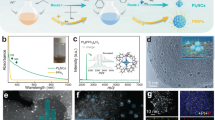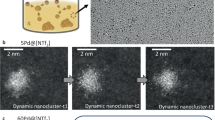Abstract
The diminished surface-area-normalized catalytic activity of highly dispersed Pt nanoparticles compared with bulk Pt is particularly intricate, and not yet understood. Here we report on the oxygen reduction reaction (ORR) activity of well-defined, size-selected Pt nanoclusters; a unique approach that allows precise control of both the cluster size and coverage, independently. Our investigations reveal that size-selected Pt nanoclusters can reach extraordinarily high ORR activities, especially in terms of mass-normalized activity, if deposited at high coverage on a glassy carbon substrate. It is observed that the Pt cluster coverage, and hence the interparticle distance, decisively influence the observed catalytic activity and that closely packed assemblies of Pt clusters approach the surface activity of bulk Pt. Our results open up new strategies for the design of catalyst materials that circumvent the detrimental dispersion effect, and may eventually allow the full electrocatalytic potential of Pt nanoclusters to be realized.
This is a preview of subscription content, access via your institution
Access options
Subscribe to this journal
Receive 12 print issues and online access
$259.00 per year
only $21.58 per issue
Buy this article
- Purchase on Springer Link
- Instant access to full article PDF
Prices may be subject to local taxes which are calculated during checkout





Similar content being viewed by others
References
Kibsgaard, J., Gorlin, Y., Chen, Z. B. & Jaramillo, T. F. Meso-structured platinum thin films: Active and stable electrocatalysts for the oxygen reduction reaction. J. Am. Chem. Soc. 134, 7758–7765 (2012).
Kinoshita, K. Particle-size effects for oxygen reduction on highly dispersed platinum in acid electrolytes. J. Electrochem. Soc. 137, 845–848 (1990).
Komanicky, V. et al. Shape-dependent activity of platinum array catalyst. J. Am. Chem. Soc. 131, 5732–5733 (2009).
Markovic, N. M. & Ross, P. N. Surface science studies of model fuel cell electrocatalysts. Surf. Sci. Rep. 45, 121–229 (2002).
Peuckert, M., Yoneda, T., Betta, R. A. D. & Boudart, M. Oxygen reduction on small supported platinum particles. J. Electrochem. Soc. 133, 944–947 (1986).
Rabis, A., Rodriguez, P. & Schmidt, T. J. Electrocatalysis for polymer electrolyte fuel cells: Recent achievements and future challenges. ACS Catal. 2, 864–890 (2012).
Strasser, P. et al. Lattice-strain control of the activity in dealloyed core–shell fuel cell catalysts. Nature Chem. 2, 454–460 (2010).
Watanabe, M., Sei, H. & Stonehart, P. The influence of platinum crystallite size on the electroreduction of oxygen. J. Electroanal. Chem. 261, 375–387 (1989).
Gasteiger, H. A., Kocha, S. S., Sompalli, B. & Wagner, F. T. Activity benchmarks and requirements for Pt, Pt-alloy, and non-Pt oxygen reduction catalysts for PEMFCs. Appl. Catal. B 56, 9–35 (2005).
Mayrhofer, K. J. J. et al. The impact of geometric and surface electronic properties of Pt-catalysts on the particle size effect in electocatalysis. J. Phys. Chem. B 109, 14433–14440 (2005).
Nesselberger, M. et al. The particle size effect on the oxygen reduction reaction activity of Pt catalysts: influence of electrolyte and relation to single crystal models. J. Am. Chem. Soc. 133, 17428–17433 (2011).
Perez-Alonso, F. J. et al. The effect of size on the oxygen electroreduction activity of mass-selected platinum nanoparticles. Angew. Chem. Int. Ed. 51, 4641–4643 (2012).
Tritsaris, G. A., Greeley, J., Rossmeisl, J. & Norskov, J. K. Atomic-scale modeling of particle size effects for the oxygen reduction reaction on Pt. Catal. Lett. 141, 909–913 (2011).
Heiz, U., Vanolli, F., Trento, L. & Schneider, W. D. Chemical reactivity of size-selected supported clusters: An experimental setup. Rev. Scient. Instrum. 68, 1986–1994 (1997).
Kunz, S. et al. Size-selected clusters as heterogeneous model catalysts under applied reaction conditions. Phys. Chem. Chem. Phys. 12, 10288–10291 (2010).
Vajda, S. et al. Subnanometre platinum clusters as highly active and selective catalysts for the oxidative dehydrogenation of propane. Nature Mater. 8, 213–216 (2009).
Miller, P. E. & Denton, M. B. The transmission properties of an rf-only quadrupole mass filter. Int. J. Mass Spectrom. Ion Process. 72, 223–238 (1986).
Kettner, M., Schneider, W. B. & Auer, A. A. Computational study of Pt/Co core–shell nanoparticles: Segregation, adsorbates and catalyst activity. J. Phys. Chem. C 116, 15432–15438 (2012).
Norskov, J. K. et al. Origin of the overpotential for oxygen reduction at a fuel-cell cathode. J. Phys. Chem. B 108, 17886–17892 (2004).
Strménik, D. Active Sites for PEM Fuel Cell Reactions in Model and Real Systems PhD thesis, Univ. Ljubljana (2007).
Hartl, K. et al. Electrochemically induced nanocluster migration. Electrochim. Acta 56, 810–816 (2010).
Fuhrmann, J. et al. The role of reactive reaction intermediates in two-step heterogeneous electrocatalytic reactions: A model study. Fuel Cells 11, 501–510 (2011).
Inaba, M., Yamada, H., Tokunaga, J. & Tasaka, A. Effect of agglomeration of Pt/C catalyst on hydrogen peroxide formation. Electrochem. Solid State Lett. 7, A474–A476 (2004).
Greeley, J. et al. Alloys of platinum and early transition metals as oxygen reduction electrocatalysts. Nature Chem. 1, 552–556 (2009).
Mayrhofer, K. J. J. & Arenz, M. Log on for new catalysts. Nature Chem. 1, 518–519 (2009).
Bae, J. H., Han, J.-H. & Chung, T. D. Electrochemistry at nanoporous interfaces: New opportunity for electrocatalysis. Phys. Chem. Chem. Phys. 14, 448–463 (2012).
Strmcnik, D et al. The role of non-covalent interactions in electrocatalytic fuel-cell reactions on platinum. Nature Chem. 1, 466–472 (2009).
Stern, O. The theory of the electrolytic double shift. Z. Elektrochem. Angew. Phys. Chem. 30, 508–516 (1924).
Delahay, P. J. Double Layer and Electrode Kinetics (Interscience, 1965).
Schweinberger, F. F. Catalysis with Supported Size-selected Pt Clusters PhD thesis, Technische Universität München (2013).
Mayrhofer, K. J. J., Wiberg, G. K. H. & Arenz, M. Impact of glass corrosion on the electrocatalysis on Pt electrodes in alkaline electrolyte. J. Electrochem. Soc. 155, P1–P5 (2008).
Torquato, S., Lu, B. & Rubinstein, J. Nearest-neighbor distribution-functions in many-body systems. Phys. Rev. A 41, 2059–2075 (1990).
Hamou, R. F., Biedermann, P. U., Erbe, A. & Rohwerder, M. Numerical simulation of probing the electric double layer by scanning electrochemical potential microscopy. Electrochim. Acta 55, 5210–5222 (2010).
Macdonald, J. R. & Barlow, C. A. Theory of double-layer differential capacitance in electrolytes. J. Chem. Phys. 36, 3062–3080 (1962).
Booth, F. Dielectric constant of polar liquids at high field strengths. J. Chem. Phys. 23, 453–457 (1955).
Acknowledgements
This work was supported by the Danish DFF through grant # 10-081337 and the German DFG through the Emmy Noether project Are852/1-1. The authors would like to acknowledge the contributions of M. Thämer and A. Kartouzian for the preparation of the Pt20 samples.
Author information
Authors and Affiliations
Contributions
M.A., K.J.J.M. and S.K. designed and built the transfer chamber. S.K., F.F.S. and U.H. designed the cluster experiment and deposited the cluster samples. M.R. performed the SEM measurements. M.A. and K.J.J.M. designed the electrochemical measurements. M.N., S.A, G.K.H.W., K.S. and M.R. performed and analysed the electrochemical measurements. R.F.H. and P.U.B. performed and analysed the computational modelling. M.A. wrote the paper.
Corresponding author
Ethics declarations
Competing interests
The authors declare no competing financial interests.
Supplementary information
Supplementary Information
Supplementary Information (PDF 1239 kb)
Rights and permissions
About this article
Cite this article
Nesselberger, M., Roefzaad, M., Fayçal Hamou, R. et al. The effect of particle proximity on the oxygen reduction rate of size-selected platinum clusters. Nature Mater 12, 919–924 (2013). https://doi.org/10.1038/nmat3712
Received:
Accepted:
Published:
Issue Date:
DOI: https://doi.org/10.1038/nmat3712
This article is cited by
-
Nanoparticle proximity controls selectivity in benzaldehyde hydrogenation
Nature Catalysis (2024)
-
Advanced electrochemical techniques for characterizing electrocatalysis at the single-particle level
Carbon Neutrality (2023)
-
Nitrogen-skinned carbon nanocone enables non-dynamic electrochemistry of individual metal particles
Science China Chemistry (2022)
-
Pure Metal Clusters with Atomic Precision for Nanomanufacturing
Nanomanufacturing and Metrology (2022)
-
Atomically precise control in the design of low-nuclearity supported metal catalysts
Nature Reviews Materials (2021)



